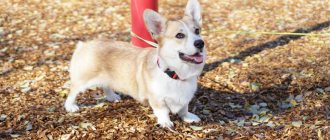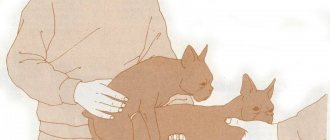January 27, 2020
On one of the dog breeders’ forums I came across the following statement: “A dog is a luxury!” I thought about it. Indeed, in terms of the complexity of keeping this animal, it is perhaps second only to a horse or a monkey. And first of all, the difficulties are associated with the need for daily walks.
Many people deny themselves the pleasure of having a dog only because they do not have the opportunity to walk with it as much as necessary. And this is a position that deserves respect. In fact, we often see that owners force the animal to lead a lifestyle that is convenient for humans, regardless of the needs of their four-legged friend.
And they, these needs, exist, and are quite specific. Let me make a reservation right away that we are not talking about the administration of natural needs. To do this, 10 minutes a day is enough, or you don’t even need to go outside at all - you can teach your dog to go to the toilet at home, in a specially designated place.
I won’t say what it’s like from the point of view of living space hygiene. This is a personal question for each person, and then, again, this is not what we are talking about.
How many times a day should you walk your dog?
Walking the dog is an essential aspect of keeping a four-legged friend. The pet needs to manage its affairs, run around a lot, gain new information in the form of fresh smells, and the like. In addition, for the owner, walking the pet is also of great importance - without this, you will have to clean up the pet’s waste products in the house every day, train the dog in a confined space, which is very inconvenient and impractical, and endure pranks in the form of damage to property, which will certainly arise if the pet is not allowed in to the yard.
Every day we come across many dog owners walking their four-legged friends - small Pekingese and lap dogs, strong bulldogs and Rottweilers, proud Dobermans and shepherds, cute Labradors and setters.
The variety and number of dogs is amazing and pleasing, but not everyone understands how to get along with a pet, where, how and how many times a day to walk a dog. Therefore, it is important to understand the rules for walking your pet.
Washing the puppy after a walk
If the puppy gets very dirty during a walk, it is necessary to wash it. For the first time, you should gently walk over the contaminated areas with a slightly dampened rag soaked in warm water, using a high-quality specialized shampoo intended for a puppy. Then wipe with a soft towel and comb the fur.
If you cannot do without thoroughly washing the puppy, then you must follow the following rules. Prepare a basin half filled with warm water (temperature should not exceed 30 degrees). You can measure the temperature of the water with a special thermometer. Be careful not to let water get into your pet's ears. You should wash your puppy with smooth movements, but at an accelerated pace. Under no circumstances should you scare a puppy with water pressure. Such an event will remain in his memory, and he will have a negative attitude towards subsequent washing. Do not direct a stream of water at the puppy's head.
You should know that experts do not recommend washing your puppy more than once a month. Frequent washing is bad for his coat. Therefore, washing a puppy should only be done in exceptional cases.
How to walk your dog correctly
In the first days and weeks after the arrival of a new four-legged family member, the owners happily shower the dog with care and attention. Everyone tries to make sure that the puppy is not hungry, everyone is in a hurry to take it for a walk and give it a bath. But, unfortunately, in most cases this enthusiasm quickly fades, and the owners get tired of taking care of their pet.
Not everyone wants to waste time on the same manipulations, adjust their daily routine to suit a small fluffy ball and simply feel responsible to their pet.
For this reason, far-sighted people often refuse to get a dog, no matter how strong the desire or requests of the children. But those who are still aware of their capabilities and understand that they can provide their pet with the necessary care must understand all the issues of maintenance, in particular, how and how many times to walk the dog .
Before the owner is going to take the dog out, he needs to put on the necessary set of equipment - a collar or harness, a leash, a muzzle. Be sure to praise and encourage your pet at this moment so that he feels in a good mood.
It is useful to reinforce what is happening with sound commands “Walk!” or “Out on the street!” or interpretations. Gradually, the puppy will learn to associate such actions with subsequent walking and will behave correctly on command.
It is important to have constant contact with your dog while walking. It’s good to talk to your four-legged friend throughout the entire route - call his name warmly and affectionately, just tell him something so that the dog hears the owner’s voice. In case of disobedience, you need to raise your tone, sternly reprimand the puppy and direct his energy in the right direction.
You need to have a basic main route. After confidently mastering it, it is useful to change your walking routes in order to expand your walking area, discover new interesting places and explore the maximum number of paths to your home. There is no need to suddenly change the route so that the dog does not feel confused and frightened by sudden new places.
In hot weather, you need to protect your dog from overheating and burns, and in cold weather, from freezing. Clothes come in handy for this. In summer it is good to put a special panama hat or cap made for dogs on your pet’s head, and in winter - overalls, jackets and other warm clothes. Also, dog shoes will protect paws from hot asphalt in summer and cold snow in winter.
It’s just important not to go too far and not to wrap your pet up too much. Still, the appearance of a dog that is as close as possible to its natural appearance is the most useful. Therefore, the characteristics of the breed are taken into account.
How many times should you walk your dog
New dog owners are often confused when faced with the problem of how many times they need to walk their dog . This is a purely individual matter - you need to take into account the breed and, most importantly, the age of the pet.
The younger the dog, the more often it goes to the toilet and, therefore, the more it needs to be taken out into the yard. 2-3 month old puppies should be walked at least 4-6 times a day, you can walk them up to 7-8 times. Gradually, the number of walks is gradually reduced, and the duration, accordingly, increases.
Thus, young dogs under one year of age need to be taken out at least 3 times a day. From the age of one year, dogs are walked at least 2 times - in the morning and in the evening. Less often is not possible.
The duration of walks is different for each dog. The younger the dog, the faster it gets tired and needs to rest. So, for small puppies, 15 - 20 minutes for each walk is enough; as they grow, they need to increase the duration of exercise to 1.5 - 2 hours.
How long to walk a puppy on his first walk
In order for a puppy to grow up strong and healthy, it must be provided with the best living conditions. The need for daily walks is as follows:
· training your pet to relieve itself on the street;
· Fresh air;
· excellent physical condition;
· development and strengthening of muscles;
· adaptation to external environmental conditions;
· communication with other animals.
In addition, walks serve as a good measure of influence for getting closer to the owner in an unfamiliar environment. With the help of walks, the puppy learns proper behavior with strangers.
The first walk with the puppy can be done no earlier than two weeks after completion of vaccination. It is recommended to complete the full course of vaccination for your puppy no later than four months of age.
For the first time, you should spend no more than half an hour walking. In the future, you can spend more time walking, gradually increasing it. For the following walks you should allocate from an hour to three hours of free time.
Which dogs should you not walk?
It should be immediately noted that there is no breed of dog that does not need to be walked at all. However, small dogs - Chihuahua, Japanese Chin, Miniature Pinscher, Toy Terrier, Pomeranian Spitz, Yorkshire Terrier, as well as lazy pugs - quickly get tired during physical activity, and they themselves are often not eager to go out into the yard.
Such dogs can be taken out much less frequently, allowing them to stay at home for several days, if necessary. To avoid unpleasant situations, you need to teach couch potatoes to relieve themselves in a litter tray, diaper or other special toilet for dogs.
It is worth remembering that by completely ceasing to take the pet outside, the owner runs the risk of eventually getting a malicious, scandalous dog that has problems not only with the psyche, but also with physical health. Without socialization and receiving information from the yard, dogs' character deteriorates, phobias and psychoses arise. Therefore, the question of how many times a day to walk a dog is important for all owners, even the smallest and laziest dogs.
Should small breed dogs be walked?
For small and dwarf dog breeds, it is enough to run a couple of circles around the dinner table to get tired. For this reason, most owners do not bother walking such dogs, acquiring only toys and trays for them. However, running and frolicking in the fresh air for little pets, jumping on the grass, and in the winter - on a snowball is very useful.
For hounds, hunting and service dogs, daily active walks are simply vital. It’s not even worth getting such a dog if the owner is always busy or simply has no desire to bother with the pet, take it out and train it every day.
Walking for sick dogs
Regarding the exercise of sick and recovering pets, you should definitely consult a veterinarian. For example, with some diseases of the cardiovascular system and the musculoskeletal system, dogs need to move, but they should not be overtired and do too many exercises.
If your pet is tired, feels unwell and lies down, you should not torment him or force him to continue on his way. You need to give the dog a rest and recuperate. You should wait until your pet gets better, praise and encourage him, carefully monitoring and assessing the dog’s condition.
There is no need to restrict a sick dog from the street unless there are special instructions for this - even resting in the fresh air is healthier than sitting at home all day.
Young and frisky dogs that have been injured and undergoing treatment are better off walking on a leash. They often forget themselves, distracted by many interesting distractions on the street, so they strive to perform prohibited maneuvers, which can easily harm themselves.
Walking a dog during heat or pregnancy
During estrus, bitches need walks just as much as always. Moreover, exercise may even be delayed, because enlarged genitals during estrus provoke more frequent and frequent trips to the toilet. However, in order to avoid unwanted increased attention from male dogs and even more so unnecessary mating, it is useful to change the route, choosing a less crowded one, as well as a walking time, so as to meet fewer dogs . You will have to take your pet out on a leash without letting go.
Proper physical activity is very important for pregnant bitches. You need to carefully assess its condition in order to decide how many times a day to walk the dog. You should not chase your pet and allow it to become overtired, but measured walking will be useful.
For puppies and already lactating dogs, feasible exercise is beneficial. It is necessary to take her out into the yard even more often than usual, but the time spent outside should be reduced to 20–30 minutes.
Walking at different ages
Dog handlers advise walking an adult animal three to four times a day. Although many owners who have no one in the family to take the dog out at lunchtime, walk it twice: in the morning and in the evening. The morning walk is usually shorter - about half an hour, and the evening walk should be at least one and a half hours. In addition, it is advisable to go out into nature with your pet for a few hours on weekends.
Puppies up to six months need to be walked every two to three hours. The more often you take your puppy out, the faster he will learn to go to the toilet outside. After six months, the amount of walking can be reduced, adding time for the dog to properly frolic. If the puppy walks enough, he behaves much calmer at home: he chews less furniture, howls and runs around the house.
The fact is that it is during walks that the puppy’s nervous system develops correctly. As he gets to know the world, he socializes faster and more correctly and becomes less fearful.
Safety on the street comes first
Train your puppy not to react to passing traffic. However, if your pet is afraid of something, switch his attention to the toy and calm him down. Do not allow barking at people passing by. If the puppy reacts inappropriately to passers-by, it is better to walk in deserted places for the first time. Go outside for the first time in warm, dry weather, not lower than 10 degrees. Make sure that the puppy does not freeze and moves actively and do not allow him to pick up anything from the ground. Just in case, hang a tag with your phone number on your dog's collar.
How long to walk with dogs of different breeds
Representatives of small breeds, such as the Yorkshire terrier, chihuahua, and miniature pinscher, are often taught by their owners to go to the toilet in a litter box in the house. But that doesn't mean these dogs don't need a walk. They also need to be taken out into the fresh air and allowed to run, otherwise the dog will risk obesity.
Representatives of active breeds: hunting dogs, service dogs and athletes need not just walks, but also mandatory special exercises on the site, where they can sufficiently expend energy and train.
Seasonal walking
In the summer heat, it is better to postpone walking the dog to a cooler time: take it out earlier in the morning and later in the evening. It is better not to take even a puppy (especially a black one) outside on a hot afternoon. In winter, on the contrary, you can shift (if possible) walks to lighter and warmer times. Later in the morning, earlier in the evening. In severe frosts, it is better not to walk your dog for a long time; short-haired breeds need to be dressed.
However, you should not start active games in the bitter cold so that the dog does not overheat in clothes and does not breathe heavily in cold air.
Walking a sick dog
If you have health problems (chronic or during recovery), you should consult your doctor about the specifics of walking. Animals suffering from cardiovascular diseases and obesity should not move intensively. However, movement is necessary for them.
Therefore, such dogs are walked for a long time, but slowly walking in a calm rhythm. For an animal with problems in the joints and spine, every step can cause pain, and therefore it is better to give the dog the opportunity to walk at the rhythm that it chooses. Let him even just lie on the fresh grass for half an hour. It will be healthier than lying in the apartment.
During the recovery period after injuries and operations, the dog should not be physically stressed and care must be taken to carefully bandage and protect wounds before going outside. If the dog is young and loves to play, it is better to walk it on a leash until it is fully recovered.
How long to walk your dog during heat and pregnancy
Due to the fact that cables can smell a bitch in heat and are very worried about this, some owners of “girls” try to spend less time walking during this period. Of course, at the first stage of estrus, the dog becomes lethargic, plays less, and may not want to walk for a long time.
But the owner should not limit the animal’s movement, which is so necessary especially for apartment dogs. In addition, the dog’s reproductive organs increase in volume during this period and put pressure on the organs of the genitourinary system, which may require a longer walk than usual.
It is better to change the time you go for a walk and take the dog out either earlier or later than the period when most dogs are walking. It is also worth changing your usual walking routes, trying not to appear in areas where dogs are walking. In the second week and until the end of her heat, the bitch should only be walked on a leash.
A pregnant dog also needs good walks. The animal should not be physically stressed; sports training should be cancelled, but it should be done quite a lot. This is beneficial for both the cardiovascular system and future puppies. It is better to take a bitch who has just had puppies outside not twice a day, but as often as possible: three or four, but not for long - for about 20 minutes. It is better to dress her in protective clothing so as not to damage her nipples.
Puppy from 3 to 4 months. Part 4
And again about walks. Before this, we talked exclusively about walking on a leash. What about free walks?
Are they necessary? And when? In my opinion, they are absolutely necessary. And the sooner you start walking your dog without a leash, the better you will be able to do this as he grows up. But one should also take into account objective reality, the dangers that threaten a small puppy without a leash. Therefore, here are some recommendations: how to properly walk without a leash.
If you are the happy owners of a fenced area, then there is no problem; you can start walking even before the end of the post-vaccination quarantine, if there are no strangers or animals in the area.
The situation is also simplified if there is a quiet place nearby that is clearly visible and away from the roadway (a field, the shore of a bay...). If you don’t have such a place, I would recommend walking on a leash for at least the first 2-3 weeks, until the puppy gets used to the street and gets used to the equipment. During this time, your connection with him will strengthen, and he will begin to respond to your voice on the street. And if something frightens the puppy, it is more likely that he will rush to seek salvation from you.
For a walk without a leash, choose a familiar place, far away from the roadway. The most important rule I want to convey is - be active! After letting the puppy off the leash, move, invite him to play and run. Call them over and give them a treat. Offer to play with toys - perhaps not the first time, but you will succeed (remember - we play “toy hunt”, the puppy’s very first game). Move, call the puppy to follow you. Comment on his actions (“What did you find? A stick? Well done! And this is a bush. And someone left this letter for you. And this is a squirrel...”). And further. You will definitely encounter situations that will become stressful for you. You can't foresee everything. For example, on one of our walks in the forest, Emma and I met a skier. Emma was very scared and ran away. I follow her, asking the skier in as calm a voice as possible to stop and not scare the little puppy. Then she brought Emma back with dances and treats and even got her to walk past the skier to me the third time. There will be stress. But it is your choice whether to walk on a leash all your life or not. I choose walks in forests and fields without a leash. This is one of the greatest pleasures in this world, in my opinion.











